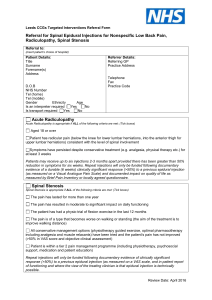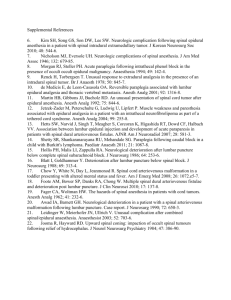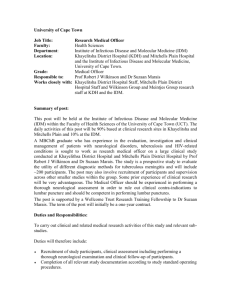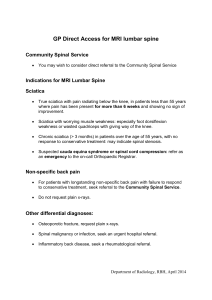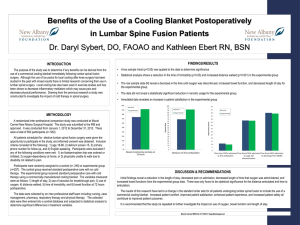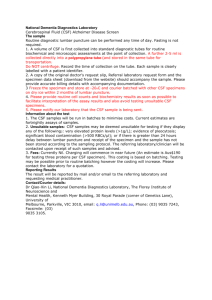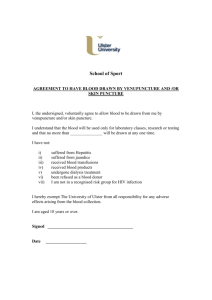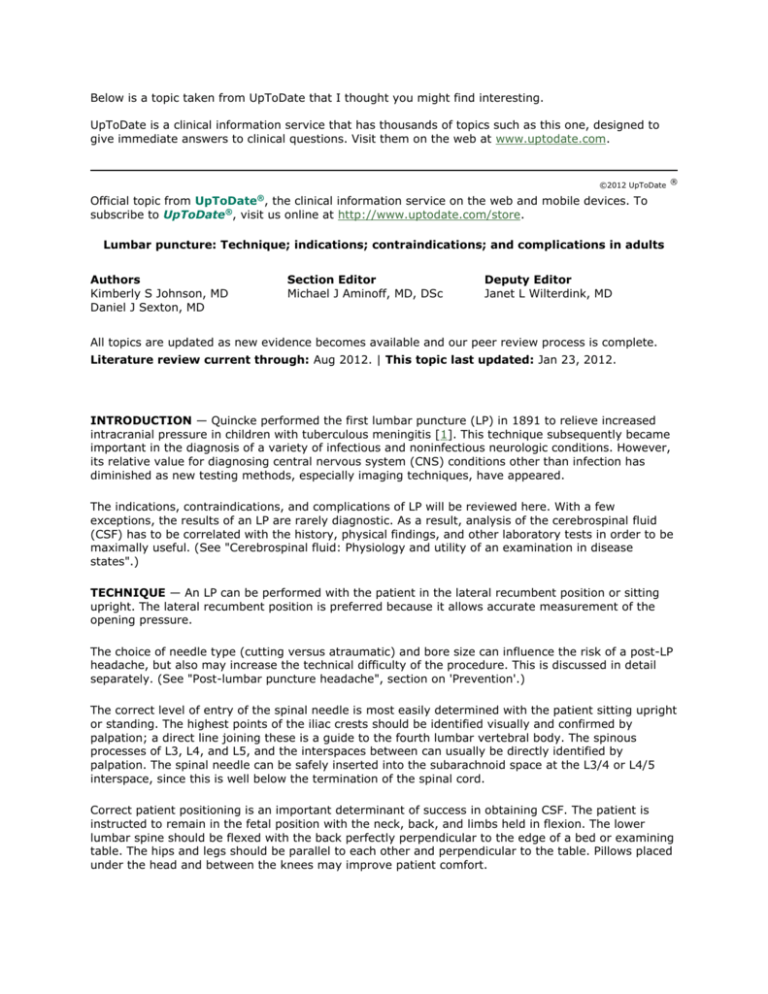
Below is a topic taken from UpToDate that I thought you might find interesting.
UpToDate is a clinical information service that has thousands of topics such as this one, designed to
give immediate answers to clinical questions. Visit them on the web at www.uptodate.com.
©2012 UpToDate ®
Official topic from UpToDate®, the clinical information service on the web and mobile devices. To
subscribe to UpToDate®, visit us online at http://www.uptodate.com/store.
Lumbar puncture: Technique; indications; contraindications; and complications in adults
Authors
Kimberly S Johnson, MD
Daniel J Sexton, MD
Section Editor
Michael J Aminoff, MD, DSc
Deputy Editor
Janet L Wilterdink, MD
All topics are updated as new evidence becomes available and our peer review process is complete.
Literature review current through: Aug 2012. | This topic last updated: Jan 23, 2012.
INTRODUCTION — Quincke performed the first lumbar puncture (LP) in 1891 to relieve increased
intracranial pressure in children with tuberculous meningitis [1]. This technique subsequently became
important in the diagnosis of a variety of infectious and noninfectious neurologic conditions. However,
its relative value for diagnosing central nervous system (CNS) conditions other than infection has
diminished as new testing methods, especially imaging techniques, have appeared.
The indications, contraindications, and complications of LP will be reviewed here. With a few
exceptions, the results of an LP are rarely diagnostic. As a result, analysis of the cerebrospinal fluid
(CSF) has to be correlated with the history, physical findings, and other laboratory tests in order to be
maximally useful. (See "Cerebrospinal fluid: Physiology and utility of an examination in disease
states".)
TECHNIQUE — An LP can be performed with the patient in the lateral recumbent position or sitting
upright. The lateral recumbent position is preferred because it allows accurate measurement of the
opening pressure.
The choice of needle type (cutting versus atraumatic) and bore size can influence the risk of a post-LP
headache, but also may increase the technical difficulty of the procedure. This is discussed in detail
separately. (See "Post-lumbar puncture headache", section on 'Prevention'.)
The correct level of entry of the spinal needle is most easily determined with the patient sitting upright
or standing. The highest points of the iliac crests should be identified visually and confirmed by
palpation; a direct line joining these is a guide to the fourth lumbar vertebral body. The spinous
processes of L3, L4, and L5, and the interspaces between can usually be directly identified by
palpation. The spinal needle can be safely inserted into the subarachnoid space at the L3/4 or L4/5
interspace, since this is well below the termination of the spinal cord.
Correct patient positioning is an important determinant of success in obtaining CSF. The patient is
instructed to remain in the fetal position with the neck, back, and limbs held in flexion. The lower
lumbar spine should be flexed with the back perfectly perpendicular to the edge of a bed or examining
table. The hips and legs should be parallel to each other and perpendicular to the table. Pillows placed
under the head and between the knees may improve patient comfort.
The overlying skin should be cleaned with alcohol and a disinfectant such as povidone-iodine or
chlorhexidine (0.5 percent in alcohol 70 percent); the antiseptic should be allowed to dry before the
procedure is begun. Many product inserts of chlorhexidine-containing solutions warn against use of
chlorhexidine prior to lumbar puncture because of a concern that it can cause arachnoiditis. The
evidence that it does so is very limited, and many experts believe that chlorhexidine has an advantage
over povidone-iodine because of its onset, efficacy, and potency [2-6]. Due to specific labeling
prohibiting use, a formal institutional policy to support such use may be indicated. After the skin is
cleaned and allowed to dry, a sterile drape with an opening over the lumbar spine is placed on the
patient. Local anesthesia (eg, lidocaine) is infiltrated into the previously identified lumbar
intervertebral space and a 20 or 22 gauge spinal needle containing a stylet is inserted into the lumbar
intervertebral space.
The spinal needle may be advanced slowly, angling slightly toward the head, as if aiming towards the
umbilicus. The flat surface of the bevel of the needle should be positioned to face the patient's flanks
to allow the needle to spread rather than cut the dural sac (the fibers of which run parallel to the
spinal axis). Many physicians choose to advance the needle incrementally, removing the stylet
periodically to check for CSF flow, then reinserting the stylet until the subarachnoid space is entered
[7]. However, others report a higher rate of successful LP when the stylet is removed, just after the
skin is punctured and before it is passed into the subarachnoid space in order to better observe the
flow of CSF upon entry of the subarachnoid space [8,9].
Once CSF appears and begins to flow through the needle, the patient should be instructed to slowly
straighten or extend the legs to allow free flow of CSF within the subarachnoid space. A manometer
should then be placed over the hub of the needle and the opening pressure should be measured
(figure 1). Fluid is then serially collected in sterile plastic tubes. A total of 8 to 15 mL of CSF is
typically removed during routine LP. However, when special studies are required, such as cytology or
cultures for organisms that grow less readily (eg, fungi or mycobacteria), 40 mL of fluid can safely be
removed. Aspiration of CSF should not be attempted as it may increase the risk of bleeding [7]. The
stylet should be replaced before the spinal needle is removed.
No trials have shown that bed rest following LP significantly decreases the risk of post LP headache
compared with immediate mobilization [10,11]. (See "Post-lumbar puncture headache", section on
'Bedrest'.)
The Queckenstedt maneuver can be used to demonstrate that there is free flow of fluid from the
ventricles to the lumbar space. This maneuver is performed by measuring the CSF pressure and then
observing the change in pressure after manual compression of both jugular veins. However, this test
is rarely useful in modern practice, since newer techniques such as magnetic resonance imaging (MRI)
and computed tomography (CT) readily identify most obstructing spinal or basilar lesions.
INDICATIONS — LP is essential or extremely useful in the diagnosis of bacterial, fungal,
mycobacterial, and viral CNS infections and, in certain settings, for help in the diagnosis of
subarachnoid hemorrhage, CNS malignancies, demyelinating diseases, and Guillain-Barré syndrome.
Urgent — The number of definite indications for LP has decreased with the advent of better
neuroimaging procedures including CT scans and MRI, but urgent LP is still indicated to diagnose two
serious conditions [12,13]:
Suspected CNS infection (with the exception of brain abscess or a parameningeal process).
Suspected subarachnoid hemorrhage (SAH) in a patient with a negative CT scan [14]. Since
red blood cells in the CSF can reflect a traumatic tap, an important finding in this setting is
xanthochromia (pink or yellow tint of the CSF supernatant), which represents hemoglobin
degradation products. Xanthochromia takes at least two hours to develop. It is a highly
sensitive marker of subarachnoid hemorrhage when the lumbar puncture is performed at least
twelve hours after the onset of symptoms [15]. The use of CSF examination in the evaluation
of a patient with suspected SAH is discussed in detail separately. (See "Etiology, clinical
manifestations, and diagnosis of aneurysmal subarachnoid hemorrhage", section on 'Lumbar
puncture' and "Cerebrospinal fluid: Physiology and utility of an examination in disease states",
section on 'Color'.)
The most common use of the LP is to diagnose or exclude meningitis in patients presenting with some
combination of fever, altered mental status, headache, or meningeal signs. Examination of the CSF
has a high sensitivity and specificity for determining the presence of bacterial and fungal meningitis.
The findings on CSF analysis also may help distinguish bacterial meningitis from viral infections of the
central nervous system. However, there is often substantial overlap. (See "Viral encephalitis in
adults", section on 'Cerebrospinal fluid findings'.)
Nonurgent — A nonurgent LP is indicated in the diagnosis of the following conditions. The findings are
discussed in the appropriate topic reviews:
Idiopathic intracranial hypertension (pseudotumor cerebri)
Carcinomatous meningitis
Tuberculous meningitis
Normal pressure hydrocephalus
CNS syphilis
CNS vasculitis
Conditions in which LP is rarely diagnostic but still useful include:
Multiple sclerosis
Guillain-Barré syndrome
Paraneoplastic syndromes
LP is also required as a therapeutic or diagnostic maneuver in the following situations [12,13,16,17]:
Spinal anesthesia
Intrathecal administration of chemotherapy
Intrathecal administration of antibiotics
Injection of contrast media for myelography or for cisternography
CONTRAINDICATIONS — Although there are no absolute contraindications to performing the
procedure, caution should be used in patients with:
Possible raised intracranial pressure
Thrombocytopenia or other bleeding diathesis (including ongoing anticoagulant therapy)
Suspected spinal epidural abscess
These are discussed in detail in relation to the complications with which they are associated. (See
'Complications' below.)
COMPLICATIONS — LP is a relatively safe procedure, but minor and major complications can occur
even when standard infection control measures and good technique are used. These complications
include:
Post-LP headache
Infection
Bleeding
Cerebral herniation
Minor neurologic symptoms such as radicular pain or numbness
Late onset of epidermoid tumors of the thecal sac
Back pain
The risk of complications was studied in a cohort of 376 patients who underwent LP for evaluation of
acute cerebrovascular disease [18]. The following frequency of complications was noted: backache (25
percent), headache (22 percent), headache and backache (12 percent), severe radicular pain (15
percent), and paraparesis (1.5 percent). Severe pain or paraparesis occurred in 6.7 percent of
patients receiving anticoagulants following the procedure and in none of the 34 patients who did not
receive anticoagulants.
Post LP headache — Headache, which occurs in 10 to 30 percent of patients, is one of the most
common complications following LP. Post-LP headache is caused by leakage of CSF from the dura and
traction on pain-sensitive structures. Patients characteristically present with frontal or occipital
headache within 24 to 48 hours of the procedure, which is exacerbated in an upright position and
improved in the supine position. Associated symptoms may include nausea, vomiting, dizziness,
tinnitus, and visual changes.
This risk factors, prevention, and treatment of post-LP headache are discussed separately. (See "Postlumbar puncture headache".)
Infection
Meningitis — Meningitis is an uncommon complication of LP. In a review of 179 cases of post-LP
meningitis reported in the medical literature between 1952 and 2005, half of all cases occurred after
spinal anesthesia; only 9 percent occurred after diagnostic LP. The most commonly isolated causative
organisms were streptococcus salivarius (30 percent), streptococcus viridans (29 percent), alphahemolytic strep (11 percent), staphylococcus aureus (9 percent), and pseudomonas aeruginosa (8
percent) [19].
While some cases of post-LP meningitis due to staphylococci, pseudomonas, and other gram-negative
bacilli have been attributed to contaminated instruments or solutions or poor technique [20], other
studies have suggested that post-LP meningitis could arise from aerosolized oropharyngeal secretions
from personnel present during the procedure especially since many of the causative organisms are
found in the mouth and upper airway [19,21-23].
Based upon these observations, some authors have recommended the routine use of face masks
during LP and neuroradiologic imaging procedures involving LP [24-26]. Others have questioned the
practicality and necessity of the use of face masks since there is no proof that face masks prevent
such infections [22,27]. In 2005 the Healthcare Infection Control Advisory Committee recommended
that face masks be used by individuals who place a catheter or inject material into the spinal canal,
and in 2007 the CDC endorsed this recommendation [28]. These guidelines do not require use of a
face mask for routine diagnostic LP. However, we believe a face mask can reasonably be used for
diagnostic procedures especially if the procedure is likely to be prolonged or difficult, or if the person
carrying out the procedure has an upper respiratory tract infection. (See "General principles of
infection control".)
Because meningitis can be caused in animals by performing an LP after first inducing a bacteremia
[29,30], several authors have speculated that an LP in a bacteremic patient without preexisting
meningitis might actually cause meningitis [31]. However, this phenomenon is rare, if it occurs at all.
In a retrospective study of 1089 bacteremic infants, the incidence of spontaneous meningitis in
children who underwent LP and subsequently developed meningitis was not statistically different from
those who did not undergo LP (2.1 versus 0.8 percent) [32]. We agree with other authors that
theoretical concerns about inducing meningitis in patients with bacteremia should not be used as the
basis to forego LP if meningitis is suspected [27].
An LP through a spinal epidural abscess can result in the spread of bacteria into the subarachnoid
space. Because an LP is not needed for diagnosis, the procedure should NOT be performed in most
patients with suspected epidural abscess in the lumbar region [33]. (See "Epidural abscess".)
Other infections — There are rare anecdotal case reports of discitis and vertebral osteomyelitis
following LP. Most cases were due to normal skin flora such as Propionibacterium species and
coagulase negative staphylococci [34-36]. These complications presumably result from direct
inoculation of bacteria into the vertebral bone.
Bleeding — The CSF is normally acellular, although up to five red blood cells (RBCs) are considered
normal after LP due to incidental trauma to a capillary or venule. A higher number of RBCs is seen in
some patients in whom calculation of the white blood cell (WBC) to RBC ratio and the presence or
absence of xanthochromia may differentiate LP-induced from true CNS bleeding. (See "Cerebrospinal
fluid: Physiology and utility of an examination in disease states", section on 'Cells'.)
Serious bleeding that results in spinal cord compromise has occurred in up to 1 to 2 percent of
patients in some case series [18,37]. The diagnosis of spinal hematoma is complicated by the
concealed nature of the bleeding; thus, a high index of suspicion must be maintained. Patients who
have persistent back pain or neurologic findings (eg, weakness, decreased sensation, or incontinence)
after undergoing LP require urgent evaluation (usually spinal magnetic resonance imaging (MRI)) for
possible spinal hematoma [38]. The appropriate treatment for patients with significant or progressing
neurologic deficits is prompt surgical intervention, usually a laminectomy, and evacuation of the blood.
Timely decompression of the hematoma is essential to avoid permanent loss of neurologic function
[39,40]. Patients with mild symptoms or early signs of recovery may be managed conservatively with
vigilant monitoring; dexamethasone may be administered to mitigate against neurologic injury
[41,42]. (See "Disorders affecting the spinal cord", section on 'Spinal epidural hematoma'.)
Patients who have thrombocytopenia or other bleeding disorders or in those who received
anticoagulant therapy prior to or immediately after undergoing LP have an increased risk of bleeding.
In a series cited above, spinal hematoma developed in 7 of 342 patients (2 percent) who received
anticoagulant therapy after undergoing LP; five of these patients developed paraparesis [18]. In one
literature review, 47 percent of 21 published cases of spinal hematoma following lumbar puncture
occurred in patients with a coagulopathy [41]. Thus, a high index of suspicion of spinal hematoma
should be maintained in all patients who develop neurologic symptoms after a lumbar puncture,
including those with no known coagulopathy. In rare cases, intraventricular, intracerebral, and
subarachnoid hemorrhage have also been reported as complications of lumbar puncture [42,43].
We are unaware of any study that examined the risk of bleeding following LP based upon the degree
of thrombocytopenia or clotting study abnormalities. Thus, at present the only guidepost is "clinical
judgment." We generally advise NOT performing an LP in patients with coagulation defects who are
actively bleeding, have severe thrombocytopenia (eg, platelet counts <50,000 to 80,000/µL), or an
INR >1.4, without correcting the underlying abnormalities [44,45]. When an LP is considered urgent
and essential in a patient with an abnormal INR or platelet count in whom the cause is not obvious,
consultation with a hematologist may provide the best advice for safe correction of the coagulopathy
prior to performing the LP. (See "Evaluation and management of thrombocytopenia by primary care
physicians", section on 'Invasive procedures'.)
For elective procedures in a patient receiving systemic anticoagulation, observational studies and
expert opinion have suggested stopping unfractionated intravenous heparin drips two to four hours,
stopping low-molecular-weight heparin 12 to 24 hours, and stopping warfarin five to seven days
before spinal anesthesia or LP [46,47]. This presumes that the underlying indications for
anticoagulation therapy allow a temporary suspension of treatment. While the optimal timing of
restarting anticoagulation after LP is not known, the incidence of spinal hematoma in the abovementioned series was much lower when anticoagulation was started at least one hour after the LP
[18]. Subcutaneous heparin administration is not believed to pose a substantial risk for bleeding after
LP if the total daily dose is less than 10,000 units.
Aspirin has not been shown to increase the risk of serious bleeding following LP. In a prospective
study of 924 patients who underwent orthopedic procedures with spinal or epidural anesthesia, 386
patients were taking antiplatelet therapy prior to surgery; 193 were taking aspirin [48]. Neither
aspirin nor any other antiplatelet agents were associated with an increased risk of bleeding. However,
none of these patients was taking clopidogrel, ticlopidine, or a GP IIa/IIIb receptor antagonist. Female
gender, increased age, a history of excessive bruising/bleeding, hip surgery, continuous catheter
anesthetic technique, large needle gauge, multiple needle passes, and moderate or difficult needle
placement were all significant risk factors for minor bleeding at the site of catheter placement [48].
Given the unknown risk of bleeding with thienopyridine derivatives (clopidogrel, ticlopidine) it may be
reasonable to suspend treatment with these agents, when possible, for one to two weeks prior to an
elective LP, while pharmacologic data suggests that for GP IIa/IIIb receptor antagonists, a shorter
period of treatment cessation (8 hours for tirofiban and eptifibatide and 24 to 48 hours for abciximab)
may be indicated [47].
In all cases, the relative risk of performing an LP has to be weighed against the potential benefit (eg,
diagnosing meningitis due to an unusual or difficult to treat pathogen). In cases in which LP is
considered necessary but the risk of bleeding is considered to be high, it may be useful to perform the
procedure under fluoroscopy to reduce the chance of accidental injury to small blood vessels.
Cerebral herniation — The most serious complication of LP is cerebral herniation. Suspected increased
intracranial pressure (ICP) is a relative contraindication to performance of an LP and also requires
independent assessment and treatment. The magnitude of the risk was evaluated in a report of 129
patients with increased ICP: 15 patients (12 percent) had an unfavorable outcome within 48 hours of
LP [49]. Similar findings were noted in a series of 55 patients with subarachnoid hemorrhage: seven
patients (13 percent) experienced neurologic deterioration during or soon after an LP, six of whom had
evidence of cerebral dislocation [50]. Cardiorespiratory collapse, loss of consciousness, and death may
follow. (See "Evaluation and management of elevated intracranial pressure in adults".)
A 1969 study of 30 patients with increased ICP who deteriorated after LP attempted to identify the
clinical features of patients who were at greatest risk for this complication [51]. The following findings
were noted: 73 percent had focal findings on neurologic examination (including dysphagia,
hemiparesis, and cranial nerve palsies); 30 percent had documented papilledema prior to the LP; and
30 percent had evidence of increased ICP on plain skull films (erosion of the posterior clinoid
processes). Deterioration occurred immediately in one-half of the patients, with the remainder
declining within 12 hours.
The concern about this serious complication has resulted in routine CT scanning prior to LP being the
standard of care in many emergency departments. At one institution, for example, 78 percent of
patients with suspected meningitis underwent CT scanning before the LP was performed [52].
However, this practice, when applied to patients with suspected bacterial meningitis, delays the
performance of LP, which in turn may delay treatment or limit the diagnostic power of CSF analysis
when performed after antibiotic administration. Moreover, CT scanning is not necessary in all patients
prior to LP and may not be adequate to exclude elevated ICP in others [53,54]. Some studies suggest
that high-risk patients can be identified, allowing the majority of patients to safely undergo LP without
screening CT [52,55]. This was best illustrated in a prospective study of 301 adults with suspected
meningitis [52]. The following findings were noted:
Among the 235 (78 percent) who underwent CT scan before LP, 24 percent had an abnormal
finding but only 5 percent (11 patients) had a mass effect.
The risk of an abnormal CT scan was associated with specific clinical features (presence of
impaired cellular immunity, history of previous central nervous system disease, or a seizure
within the previous week), as well as certain findings on neurologic examination (reduced level
of consciousness, and focal motor or cranial abnormalities).
Among 96 patients with none of these abnormalities, only three had an abnormal CT scan;
one of the three misclassified patients had a mild mass effect but all three underwent LP
without herniation.
Compared to patients who did not undergo CT scan before LP, those who underwent CT scan
before LP had an average of a two-hour delay in diagnosis and a one-hour delay in therapy.
Based upon these observations, we do NOT perform a CT scan before an LP in patients with suspected
bacterial meningitis unless one or more risk factors is present:
Altered mentation
Focal neurologic signs
Papilledema
Seizure within the previous week
Impaired cellular immunity
Patients with these clinical risk factors should have a CT scan to identify possible mass lesion and
other causes of increased ICP. Mass lesions causing elevated ICP are usually easily identified on CT
scan. However, the CT scan should also be scrutinized for more subtle signs including diffuse brain
swelling as manifest by loss of differentiation between gray and white matter and effacement of sulci,
as well as ventricular enlargement and effacement of the basal cisterns [56].
Independent of the decision to perform LP, patients with possible elevated ICP based upon the above
clinical features may require urgent life-saving interventions to lower ICP that may include head
elevation, hyperventilation to a PCO2 of 26 to 30 mmHg, and intravenous mannitol (1 to 1.5 g/kg).
When indicated, these should NOT await CT scan. The evaluation and management of patients with
elevated ICP is discussed in detail separately. (See "Evaluation and management of elevated
intracranial pressure in adults", section on 'Urgent situations'.)
When the LP is delayed or deferred in the setting of suspected bacterial meningitis, it is important to
obtain blood cultures (which reveal the pathogen in more than half of patients) and promptly institute
antibiotic therapy. Urgent evaluation and treatment of increased intracranial pressure, along with the
administration of antibiotics and steroids, should be instituted promptly when this is suspected.
Specific treatments are discussed separately. (See "Initial therapy and prognosis of bacterial
meningitis in adults", section on 'Avoidance of delay'.)
Others
Epidermoid tumor — The formation of an epidermoid spinal cord tumor is a rare complication of LP
that may become evident years after the procedure is performed [57-59]. Most reported cases are
children ages 5 to 12 years who had a LP in infancy; however this has also been described in adults
[60-62]. It may be caused by epidermoid tissue that is transplanted into the spinal canal during LP
without a stylet, or with one that is poorly fitting. This complication probably can be avoided by using
spinal needles with tight-fitting stylets during LP [63,64].
Abducens palsy — Both unilateral and bilateral abducens palsy are reported complications of LP [6567]. This is believed to result from intracranial hypotension and is generally accompanied by other
clinical features of post LP headache. Most patients recover completely within days to weeks. Other
cranial nerve palsies are rarely reported [68].
Radicular symptoms and low back pain — It is not uncommon (13 percent in one series) for patients
to experience transient electrical-type pain in one leg during the procedure [69]. However, more
sustained radicular symptoms or radicular injury appear to be rare [70].
Up to one-third of patients complain of localized back pain after LP; this may persist for several days,
but rarely beyond [69].
SUMMARY AND RECOMMENDATIONS — Lumbar puncture (LP) is essential or extremely useful in
the diagnosis of bacterial, fungal, mycobacterial, and viral CNS infections and, in certain settings, for
help in the diagnosis of subarachnoid hemorrhage, CNS malignancies, demyelinating diseases, and
Guillain-Barré syndrome.
LP is a relatively safe procedure, but minor and major complications can occur, including
headache, infection, bleeding, cerebral herniation, as well as minor neurologic symptoms such
as radicular pain or numbness.
Meningitis is a relatively rare complication of LP. (See 'Meningitis' above.)
LP is contraindicated in patients with a suspected spinal epidural abscess.
Suspected bacteremia is NOT a contraindication to LP.
We suggest the use of a face mask for diagnostic LP if the procedure is expected to be
prolonged or difficult or if the operator has an upper respiratory tract infection.
Bleeding in the epidural or subdural space following LP may occur in up to 2 percent of
patients, primarily in those patients with thrombocytopenia or other bleeding disorders or in
those who have received anticoagulant therapy. (See 'Bleeding' above.)
Antiplatelet therapy with aspirin and nonsteroidal anti-inflammatory agents is NOT clearly
associated with an increased risk of bleeding after LP. The bleeding risk associated with
thienopyridine derivatives or GP IIb/IIIa-receptor antagonists is unknown. It is reasonable to
suspend therapy, when possible, prior to elective LP.
Anticoagulation therapy is generally suspended, when possible, prior to elective LP.
We recommend NOT performing an LP in patients with coagulation defects who are actively
bleeding, have severe thrombocytopenia (eg, platelet counts <50,000 to 80,000/µL), or an
INR >1.4, without correcting the underlying abnormalities.
When an LP is considered essential in this setting, consultation with a hematologist may
provide the best advice for safe correction of the coagulopathy prior to LP.
Cerebral herniation is a rare, but usually fatal, complication of an LP performed in an individual
with increased intracranial pressure (ICP). While routine neuroimaging, usually brain
computed tomography (CT), before LP is not indicated in all patients, those with suspected
increased intracranial pressure (altered mentation, focal neurologic signs, papilledema, recent
seizure, and impaired cellular immunity) should have a CT scan to rule out possible mass
lesion and other causes of increased intracranial pressure. (See 'Cerebral herniation' above.)
Independent of a decision to perform LP, patients with suspected elevated ICP may require
urgent interventions to lower ICP. (See "Evaluation and management of elevated intracranial
pressure in adults", section on 'Urgent situations'.)
When the LP is delayed or deferred in a patient with suspected meningitis, it is important to
obtain blood cultures and promptly institute antibiotic therapy. (See "Initial therapy and
prognosis of bacterial meningitis in adults", section on 'Avoidance of delay'.)
Use of UpToDate is subject to the Subscription and License Agreement.
REFERENCES
1
Quincke HI. Lumbar puncture. In: Diseases of the nervous system, Church A. (Ed), Appleton, New
York 1909. p.223.
2
Scott M, Stones J, Payne N. Antiseptic solutions for central neuraxial blockade: which concentration
of chlorhexidine in alcohol should we use? Br J Anaesth 2009; 103:456; author reply 456.
3
Hebl JR. The importance and implications of aseptic techniques during regional anesthesia. Reg
Anesth Pain Med 2006; 31:311.
4
Arendt KW, Segal S. Present and emerging strategies for reducing anesthesia-related maternal
morbidity and mortality. Curr Opin Anaesthesiol 2009; 22:330.
Greenberg BM, Williams MA. Infectious complications of temporary spinal catheter insertion for
5 diagnosis of adult hydrocephalus and idiopathic intracranial hypertension. Neurosurgery 2008;
62:431.
6
Sakuragi T, Yanagisawa K, Dan K. Bactericidal activity of skin disinfectants on methicillin-resistant
Staphylococcus aureus. Anesth Analg 1995; 81:555.
7
Ellenby MS, Tegtmeyer K, Lai S, Braner DA. Videos in clinical medicine. Lumbar puncture. N Engl J
Med 2006; 355:e12.
8 Agrawal D. Lumbar puncture. N Engl J Med 2007; 356:424; author reply 425.
9
Baxter AL, Fisher RG, Burke BL, et al. Local anesthetic and stylet styles: factors associated with
resident lumbar puncture success. Pediatrics 2006; 117:876.
10
Thoennissen J, Herkner H, Lang W, et al. Does bed rest after cervical or lumbar puncture prevent
headache? A systematic review and meta-analysis. CMAJ 2001; 165:1311.
11
Sudlow C, Warlow C. Posture and fluids for preventing post-dural puncture headache. Cochrane
Database Syst Rev 2002; :CD001790.
12
Gorelick PB, Biller J. Lumbar puncture. Technique, indications, and complications. Postgrad Med
1986; 79:257.
13
The diagnostic spinal tap. Health and Public Policy Committee, American College of Physicians. Ann
Intern Med 1986; 104:880.
14
Vermeulen M, van Gijn J. The diagnosis of subarachnoid haemorrhage. J Neurol Neurosurg
Psychiatry 1990; 53:365.
15
Vermeulen M, Hasan D, Blijenberg BG, et al. Xanthochromia after subarachnoid haemorrhage
needs no revisitation. J Neurol Neurosurg Psychiatry 1989; 52:826.
16 Marton KI, Gean AD. The spinal tap: a new look at an old test. Ann Intern Med 1986; 104:840.
17 Sternbach G. Lumbar puncture. J Emerg Med 1985; 2:199.
18
Ruff RL, Dougherty JH Jr. Complications of lumbar puncture followed by anticoagulation. Stroke
1981; 12:879.
19 Baer ET. Post-dural puncture bacterial meningitis. Anesthesiology 2006; 105:381.
SWARTZ MN, DODGE PR. BACTERIAL MENINGITIS--A REVIEW OF SELECTED ASPECTS. I. GENERAL
20 CLINICAL FEATURES, SPECIAL PROBLEMS AND UNUSUAL MENINGEAL REACTIONS MIMICKING
BACTERIAL MENINGITIS. N Engl J Med 1965; 272:898.
21
Domingo P, Mancebo J, Blanch L, et al. Iatrogenic streptococcal meningitis. Clin Infect Dis 1994;
19:356.
22
Gelfand MS, Abolnik IZ. Streptococcal meningitis complicating diagnostic myelography: three cases
and review. Clin Infect Dis 1995; 20:582.
23
Rubin L, Sprecher H, Kabaha A, et al. Meningitis following spinal anesthesia: 6 cases in 5 years.
Infect Control Hosp Epidemiol 2007; 28:1187.
24
Schlesinger JJ, Salit IE, McCormack G. Streptococcal meningitis after myelography. Arch Neurol
1982; 39:576.
25
de Jong J, Barrs AC. Lumbar myelography followed by meningitis. Infect Control Hosp Epidemiol
1992; 13:74.
26
Schelkun SR, Wagner KF, Blanks JA, Reinert CM. Bacterial meningitis following Pantopaque
myelography. A case report and literature review. Orthopedics 1985; 8:73.
27
Williams J, Lye DC, Umapathi T. Diagnostic lumbar puncture: minimizing complications. Intern Med
J 2008; 38:587.
Siegel JD, Rhinehart E, Jackson M et al. 2007 Guideline for Isolation Precautions: Preventing
28 Transmission of Infectious Agents in Healthcare Settings June 2007 http;
://www.cdc.gove/ncidod/dhap/pdf/isolatons2007.pdf.
29
PETERSDORF RG, SWARNER DR, GARCIA M. Studies on the pathogenesis of meningitis. II.
Development of meningitis during pneumococcal bacteremia. J Clin Invest 1962; 41:320.
30 Austrian, CR. Experimental meningococcal meningitis. Bull Johns Hopkins Hosp 1919; 29:183.
31
Pray, LG. Lumbar puncture as a factor in the pathogenesis of meningitis. Am J Dis Child 1941;
62:295.
32 Eng RH, Seligman SJ. Lumbar puncture-induced meningitis. JAMA 1981; 245:1456.
33
Reihsaus E, Waldbaur H, Seeling W. Spinal epidural abscess: a meta-analysis of 915 patients.
Neurosurg Rev 2000; 23:175.
34
Abolnik IZ, Eaton JV, Sexton DJ. Propionibacterium acnes vertebral osteomyelitis following lumbar
puncture: case report and review. Clin Infect Dis 1995; 21:694.
35
Findlay L, Kemp FH. Osteomyelitis of the spine following lumbar puncture. Arch Dis Child 1943;
18:102.
36 Wald ER. Risk factors for osteomyelitis. Am J Med 1985; 78:206.
37
Glotzbecker MP, Bono CM, Wood KB, Harris MB. Postoperative spinal epidural hematoma: a
systematic review. Spine (Phila Pa 1976) 2010; 35:E413.
38
Braun P, Kazmi K, Nogués-Meléndez P, et al. MRI findings in spinal subdural and epidural
hematomas. Eur J Radiol 2007; 64:119.
39
Vandermeulen EP, Van Aken H, Vermylen J. Anticoagulants and spinal-epidural anesthesia. Anesth
Analg 1994; 79:1165.
40
Lawton MT, Porter RW, Heiserman JE, et al. Surgical management of spinal epidural hematoma:
relationship between surgical timing and neurological outcome. J Neurosurg 1995; 83:1.
41
Sinclair AJ, Carroll C, Davies B. Cauda equina syndrome following a lumbar puncture. J Clin
Neurosci 2009; 16:714.
42
Adler MD, Comi AE, Walker AR. Acute hemorrhagic complication of diagnostic lumbar puncture.
Pediatr Emerg Care 2001; 17:184.
Lee SJ, Lin YY, Hsu CW, et al. Intraventricular hematoma, subarachnoid hematoma and spinal
43 epidural hematoma caused by lumbar puncture: an unusual complication. Am J Med Sci 2009;
337:143.
44
Choi S, Brull R. Neuraxial techniques in obstetric and non-obstetric patients with common bleeding
diatheses. Anesth Analg 2009; 109:648.
45
van Veen JJ, Nokes TJ, Makris M. The risk of spinal haematoma following neuraxial anaesthesia or
lumbar puncture in thrombocytopenic individuals. Br J Haematol 2010; 148:15.
46
Horlocker TT. Low molecular weight heparin and neuraxial anesthesia. Thromb Res 2001;
101:V141.
47
Layton KF, Kallmes DF, Horlocker TT. Recommendations for anticoagulated patients undergoing
image-guided spinal procedures. AJNR Am J Neuroradiol 2006; 27:468.
48
Horlocker TT, Wedel DJ, Schroeder DR, et al. Preoperative antiplatelet therapy does not increase
the risk of spinal hematoma associated with regional anesthesia. Anesth Analg 1995; 80:303.
49
KOREIN J, CRAVIOTO H, LEICACH M. Reevaluation of lumbar puncture; a study of 129 patients
with papilledema or intracranial hypertension. Neurology 1959; 9:290.
50
Duffy GP. Lumbar puncture in spontaneous subarachnoid haemorrhage. Br Med J (Clin Res Ed)
1982; 285:1163.
51 Duffy GP. Lumbar puncture in the presence of raised intracranial pressure. Br Med J 1969; 1:407.
52
Hasbun R, Abrahams J, Jekel J, Quagliarello VJ. Computed tomography of the head before lumbar
puncture in adults with suspected meningitis. N Engl J Med 2001; 345:1727.
53
Shetty AK, Desselle BC, Craver RD, Steele RW. Fatal cerebral herniation after lumbar puncture in a
patient with a normal computed tomography scan. Pediatrics 1999; 103:1284.
54
Joffe AR. Lumbar puncture and brain herniation in acute bacterial meningitis: a review. J Intensive
Care Med 2007; 22:194.
55
Gopal AK, Whitehouse JD, Simel DL, Corey GR. Cranial computed tomography before lumbar
puncture: a prospective clinical evaluation. Arch Intern Med 1999; 159:2681.
56
van Crevel H, Hijdra A, de Gans J. Lumbar puncture and the risk of herniation: when should we
first perform CT? J Neurol 2002; 249:129.
57
Potgieter S, Dimin S, Lagae L, et al. Epidermoid tumours associated with lumbar punctures
performed in early neonatal life. Dev Med Child Neurol 1998; 40:266.
58
Ziv ET, Gordon McComb J, Krieger MD, Skaggs DL. Iatrogenic intraspinal epidermoid tumor: two
cases and a review of the literature. Spine (Phila Pa 1976) 2004; 29:E15.
59
Jeong IH, Lee JK, Moon KS, et al. Iatrogenic intraspinal epidermoid tumor: case report. Pediatr
Neurosurg 2006; 42:395.
60
Miyake S, Kobayashi N, Murai N, et al. Acquired lumbar epidermoid cyst in an adult. Neurol Med
Chir (Tokyo) 2005; 45:277.
61
Prat Acín R, Galeano I. Giant occipital intradiploic epidermoid cyst associated with iatrogenic
puncture. Acta Neurochir (Wien) 2008; 150:413.
62
Park JC, Chung CK, Kim HJ. Iatrogenic spinal epidermoid tumor. A complication of spinal puncture
in an adult. Clin Neurol Neurosurg 2003; 105:281.
63
McDonald JV, Klump TE. Intraspinal epidermoid tumors caused by lumbar puncture. Arch Neurol
1986; 43:936.
64
Batnitzky S, Keucher TR, Mealey J Jr, Campbell RL. Iatrogenic intraspinal epidermoid tumors. JAMA
1977; 237:148.
65
Béchard P, Perron G, Larochelle D, et al. Case report: epidural blood patch in the treatment of
abducens palsy after a dural puncture. Can J Anaesth 2007; 54:146.
66
Anwar S, Nalla S, Fernando DJ. Abducens nerve palsy as a complication of lumbar puncture. Eur J
Intern Med 2008; 19:636.
67
Kose KC, Cebesoy O, Karadeniz E, Bilgin S. Eye problem following foot surgery--abducens palsy as
a complication of spinal anesthesia. MedGenMed 2005; 7:15.
68
Follens I, Godts D, Evens PA, Tassignon MJ. Combined fourth and sixth cranial nerve palsy after
lumbar puncture: a rare complication. A case report. Bull Soc Belge Ophtalmol 2001; :29.
69 Evans RW. Complications of lumbar puncture. Neurol Clin 1998; 16:83.
70
Hasegawa K, Yamamoto N. Nerve root herniation secondary to lumbar puncture in the patient with
lumbar canal stenosis. A case report. Spine (Phila Pa 1976) 1999; 24:915.
Topic 4832 Version 7.0 • All rights reserved.
©2012 UpToDate® • customerservice@uptodate.com
www.uptodate.com
This e-mail message may contain confidential and/or privileged information. If you are
not an addressee or otherwise authorized to receive this message, you should not use,
copy, disclose or take any action based on this e-mail or any information contained in
the
message. If you have received this material in error, please advise the sender
immediately
by reply e-mail and delete this message.
Thank you.



